TGnSync
The TGnSync consortium is composed of a wider array of companies. In addition to the chipmakers that one would expect to find (Atheros, Agere, and Intel, and Qualcomm), TGnSync notably includes manufacturers of other electronic devices. Network equipment manufacturers and even consumer electronics companies are represented. One of the goals of TGnSync is to support new networked devices in the home; promotional materials refer to sending HDTV or DVD video streams across wireless networks. The goal of streaming video probably accounts for some of the emphasis placed on high peak data rates.
TGnSync MAC Enhancements
Although the TGnSync proposal has a higher peak data rate, the group did not completely neglect the development of MAC enhancements to improve efficiency and operation. Efficiency is improved through the development of frame aggregation and bursting, as well as changes to acknowledgment policies. Some protection of older transmissions is performed at the MAC layer. Notably, several MAC enhancements are designed to save battery power, which is likely a reflection of the group's membership.
Channels, radio modes, and coexistence
Although some regulators do not allow them, the TGnSync proposal makes 40 MHz channel support mandatory. If it were adopted without change, a TGnSync chipset would support both 20 MHz and 40 MHz channels, even in regulatory domains that did not allow the latter channel bandwidth. The TGnSync proposal also has MAC features that enable the use of networks with both 20 MHz-and 40 MHz-capable stations. When stations have large amounts of data to transmit, it is possible to negotiate a temporary use of a wider channel before falling back to 20 MHz operation.
MAC operational modes can also be classified based on the types of stations in the network. Pure mode networks consist only of 802.11n stations. No protection is necessary to account for older 802.11a and 802.11g stations. Alternatively, TGnSync 802.11n devices may operate in the legacy mode just like an 802.11a or 802.11g station. Most operation, though, will be in mixed mode, where a TGnSync network must co-exist with a legacy network on the same channel, and may accept associations from older 802.11a or 802.11g stations.
Association requests are handled differently in each mode. Pure mode networks stay pure by ignoring association requests from older stations, and sending Beacon frames with an information element that directs associated stations to use only the new 802.11n transmission modes. Pure mode networks also transmit Beacon frames using the TGnSync high throughput PLCP, which makes them unreadable by legacy devices. Mixed mode access points are visible to legacy devices because they transmit Beacons using the legacy format.
Mixed mode is required to coexist with older devices. (If the experience of 802.11g deployment is any guide, most 802.11n devices are likely to operate in the mixed mode for quite some time.) Mixed mode is a broad classification with several subdivisions. Mixed capable networks will allow association from legacy devices, but do not divide time between legacy and high-throughput transmissions. Access points in managed mixed networks do actively divide the time between high-throughput transmissions and legacy transmissions. Much like the division between the contention-free period and the contention period (see Chapter 9), an AP operating in managed mixed mode will allow legacy stations their timeslice, while using mechanisms similar to the protection mechanism to reserve some timeslice for MIMO stations only.
Aggregation and bursting
Initial 802.11 stations typically send frames in the order they are received. For throughput purposes, it is highly desirable to reorder frames so that they can coalesce into larger aggregated frames. Aggregation in TGnSync is a MAC-layer function that bundles several MAC frames into a single PLCP frame for transmission.
Figure 15-9 shows the basic format of a single physical-layer frame containing several MAC layer frames. Several MAC frames are put into the same PLCP frame, with an appropriate delimiter between them. The delimiter has a small reserved field, a length field for the following MAC frame, a CRC to protect the delimiter, and a unique pattern to assist in recovering individual frames from the aggregate. MAC frames are put into the aggregate without modification, and contain the full header and MAC CRC. Even if one frame out of an aggregate is lost, it may be possible to successfully receive all the remaining frames.
Figure 15-9. TGnSync frame aggregation
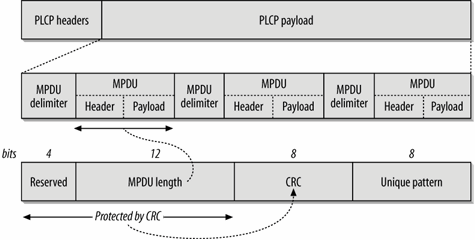
Exchanging aggregated frames is only possible once the channel has been configured for it. Figure 15-10 illustrates the process. The sender of an aggregate, called the initiator, must send an Initiator Aggregation Control (IAC) frame. IAC frames work much like RTS frames, but have additional fields to assist with channel control. Initiators can request channel measurements, offer different types of coding on the aggregate frame, and accept aggregates in the return direction. Upon receiving the IAC, the destination system, called the responder, generates a Responder Aggregation Control (RAC) frame. RAC frames work much like CTS frames: they close the loop by notifying the sender that an aggregate will be accepted, and finishing the parameter negotiation. When aggregate frames are received, an acknowledgment is required. TGnSync defines a new acknowledgment type, the BlockACK, which can be used to acknowledge all the MAC frames contained in an aggregate.
To further improve MAC efficiency, TGnSync defines a MAC header compression algorithm for use in conjunction with aggregate frames. It works in the same manner as Van Jacobsen header compression on serial dial-up lines. Frames between two destinations share most of the fields in the MAC header, most notably the MAC addresses inside the packet. Therefore, a one-byte Header ID (HID) is assigned to a unique set of the three MAC addresses inside a MAC frame. The Header ID can also save the Duration field, since the aggregate will have its own Duration, as well as the two bytes for QoS control. When frames are transmitted between the same sender
Figure 15-10. TGnSync block acknowledgment
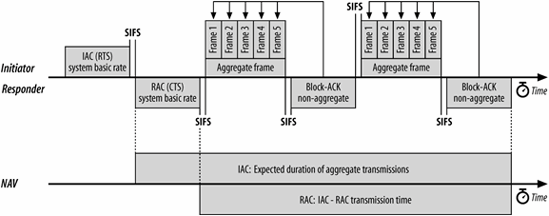
and destination, rather than repeating the same 22 bytes of header information, it is replaced by the corresponding single byte Header ID. Figure 15-11 (a) shows the use of the header compression MAC frames. First, a header frame containing the full header is transmitted, and a header ID is assigned. The header ID can be used to reference the prior full header by sending a single byte to reference previously-transmitted information about the Duration, addressing, and QoS data.
Figure 15-11 (b) illustrates the use of header compression. Five frames for two destinations from the MAC have been aggregated into a single frame for physical transmission. Rather than transmit a complete header on each constituent MAC frame in the aggregate, the system uses header compression. There are two destinations and therefore two unique MAC headers. They are each transmitted and assigned a header ID number. The five data frames following the aggregate each refer to the appropriate header number. A header ID number is unique only within the context of a single aggregate frame. Compared to transmitting full headers on all five frames, the overhead due to MAC framing is cut by more than half.
Header compression is useful when a single aggregate contains multiple frames between the same source and destination pair. However, the benefits of aggregation in TGnSync are not confined to pairs. Single-receiver aggregation is required; an optional extension allows aggregate frames to contain MAC frames for multiple receivers, in which case they are called Multiple Receiver Aggregate (MRA) frames. Inside the single transmitted aggregate frame, there are multiple Initiator Access Control frames. Each IAC specifies an offset to transmit the response to the aggregated frames, which will usually be a block acknowledgment response. To distinguish multiple receiver aggregate frames from single-receiver aggregate frames, multiple-receiver frames start with a control item called the Multiple Receiver Aggregate Descriptor (MRAD). Figure 15-12 shows the operation of multiple-receiver aggregation. The initiator's aggregate frame starts with the aggregate descriptor, and is followed by the aggregated frames for each destination. An IAC frame is used to divide them.
Figure 15-11. TGnSync MAC header compression

Figure 15-12. TGnSync MRA
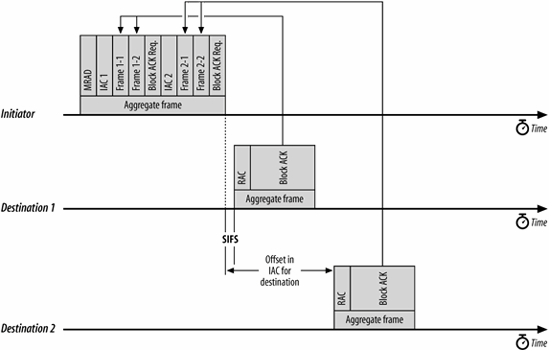
Protection
As with all PHYs that have followed existing hardware on to the market, the TGnSync proposal implements protection to avoid having the new PHY step on transmissions from the old PHY. Protection in the TGnSync proposal can take one of two main forms. The first class is based on the MAC's virtual carrier sensing mechanism with the network allocation vector. The second class is based on "spoofing," which uses the existing PLCP header format to carry duration information. Each station may make its own determination as to the appropriate mechanism.
Setting long NAV values to protect the duration of a frame exchange is a small adaptation of the 802.11g protection mechanism. At the start of a frame exchange, the RTS frame will contain a NAV long enough to protect the entire frame exchange. The RTS frame is sent using a "legacy" rate, and can be understood by existing OFDM receivers. In response, the target station sends a CTS message back, also with a long NAV value. According to the basic access rules of the MAC, other stations defer access to the medium due to the RTS/CTS clearing, and the two stations are free to exchange frames at higher data rates using modulations that would not be understood by older stations. LongNAV intervals may be terminated early by using a CF-End frame. When this protection is used for aggregate frames, the RTS is replaced by an Initiator Access Control (IAC) frame, and the CTS is replaced by a Responder Access Control (RAC) frame; the principle of operation, however, remains identical. See Figure 15-13.
Figure 15-13. TGnSync protection: LongNAV

The second class of protection is called "spoofing," and depends on setting the length field in the PLCP header. TGnSync retains the existing OFDM header described in Chapter 13. Because it is identical to the 802.11a/g format, spoofing is effective with all stations. The OFDM PLCP header contains two numbers that are used by receivers to determine how long the transmission will take. The SIGNAL field, which is shown in Figure 13-16, encodes both the transmission rate for the body and its length in bits. Stations decode the signal field and divide the number of bits by the rate to come up with an approximate transmission time.[*] To maximize the amount of time that can be spoofed, the data rate in the legacy SIGNAL field is always set to the lowest possible value of six Mbps.
[*] There are some slight offsets to account for interframe spacing, but the concept remains identical.
In pairwise spoofing, two stations will each send an incorrect length and rate so that older stations will be in receiving mode for the duration of the current frame and its next response. Newer TGnSync stations ignore the older SIGNAL field, and use an 802.11n SIGNAL field instead. Figure 15-14 illustrates pairwise spoofing. When Frame 1 is transmitted, pairwise spoofing is used to lengthen the receiving time of the frame through the end of Frame 2. TGnSync stations will interpret the spoofing as a longer NAV, and will therefore act as if the NAV were set for the duration of Frame 2. Naturally, a station within range of the responder will be set to the receiving state; if, however, there is a hidden node, the NAV will protect transmission over Frame 2. 802.11a/g stations will interpret the spoofed time as receiving time, even if they are out of range of the second frame. When Frame 2 is transmitted, it also employs pairwise spoofing to protect Frame 2 and Frame 3.
Figure 15-14. TGnSync protection: pairwise spoofing

If a long lock-out period is needed for multiple responses to a single frame, single-ended spoofing may also be used. With single-ended spoofing, the first frame in the exchange uses spoofing to protect the entire exchange, allowing all the responses to come in during the protected period. Figure 15-15 illustrates single-ended spoofing with frame aggregation. The first aggregate frame is a multiple-receiver aggregate, allowing responses from two other stations. It sets spoofed duration equal to the time expected for the entire exchange. TGnSync stations will go into receiving mode for the duration of the first frame, and then act as if the NAV were set for the spoofed duration. Legacy devices go into receiving mode for the entire spoofed duration.
Figure 15-15. TGnSync protection: single-ended spoofing
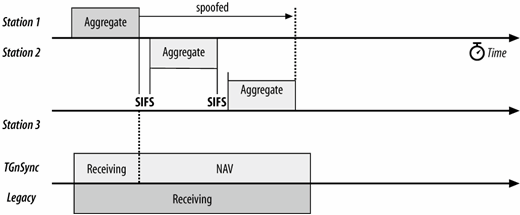
Powersaving
TGnSync defines the Timed Receive Mode Switching (TRMS) protocol to conserve energy and extend battery life. Traditional 802.11 powersaving works by completely shutting down an interface and requiring buffering at the AP. In single-input/single-output radios, there is only one RF chain to shut down. With MIMO systems, however, there can be significant power savings by shutting down unused RF chains, but retaining a single active chain to monitor the radio link. The two states of the system are called MIMO enabled for full receive capability, and MIMO disabled when all but one RF chain is shut down.
Stations activate TRMS power saving by including an information element in the association request. The basic parameter in TRMS powersaving is the hold time. After a station transmits a frame, it stays awake for the duration of the hold time. Any transmitted frame resets the hold timer to its maximum value. Setting the hold time to zero indicates that the station will remain fully operational for one slot time before sleeping.
In infrastructure networks, the AP is responsible for maintaining the TRMS hold timer for every station. If the timer elapses, the AP must conclude it has entered the MIMO disabled state, and trigger it to power on sleeping receive chains. In an independent BSS, each station must maintain a hold timer for all the other stations.
The timer is a tunable parameter. If it is set to a larger value, stations will use more power to keep the receiver fully operational. Throughput is likely to be better, but at the cost of some battery life. In some cases, network capacity may not be affected much at all. Networks that use the NAV lengthening procedure for protection must transmit the initial RTS/CTS exchange in single-antenna mode manner compatible with all OFDM stations, and will cause stations to enable MIMO operation without additional frames. Advanced transmission modes may suffer, however, because many of them require multiantenna frame exchanges to become fully operational.
TGnSync PHY Enhancements
To develop a higher peak data rate, the TGnSync proposal depends on technology similar to WWiSE. Frames are divided into spatial streams that can be multiplexed across antennas in a MIMO configuration. More aggressive coding, including a larger constellation, higher convolutional code rate, and a reduced guard interval are present to improve the data rate. Wider channels are also required by TGnSync where supported. Support for 40 MHz channels must be built in to TGnSync-compliant devices, whereas it is optional in WWiSE.
Structure of a channel
Both 20 MHz and 40 MHz channels are divided into 0.3125 MHz subcarriers, just as in 802.11a. The 20 MHz channel is identical to an 802.11a channel, and is shown in Figure 15-16 (a). The 40 MHz channel proposed in TGn Figure 15-16 (b) is a modification of the 20 MHz structure. Two 20 MHz channels are bonded together, and the resulting spectral band is divided into 128 subchannels. The center frequencies of the old 20 MHz channels are located at +/-32. The legacy channels apply a spectral mask from -6 to +6 and roll off the amplitude of transmissions at the end of the bands. With a single continuous channel, however, there is no need to use a spectral mask, and the middle of the band can be used at full strength. Full-strength transmissions in the middle of the band allow for eight new subcarriers. Using a single contiguous 40 MHz block of spectrum reclaims subcarriers that would have otherwise been wasted. Thus, in TGnSync, a 40 MHz channel provides throughput equal to 2.25 times the 20 MHz channel, rather than simply doubling the throughput. To further boost throughput, one of the pilot carriers from the 20 MHz channel is removed, so a 40 MHz channel has 6 pilot carriers instead of 8.
Figure 15-16. TGnSync channel structure

Basic MIMO rates
There are 32 modulation and coding pairs defined by the TGnSync PHY. In the basic MIMO mode, every spatial stream must use an identical modulation technique, so the data rate is simply a multiple of the single spatial stream data rate. Rather than take up a great deal of space in a table, here is a basic formula for the data rates:
Data rate (Mbps) = 12 x channel bandwidth factor x number of spatial streams x coded bits per subcarrier x code rate x guard interval factor
Channel bandwidth factor
20 MHz channels are the baseline, and are assigned a channel bandwidth factor of 1. 40 MHz channels carry more than twice the data, and are assigned a channel bandwidth factor of 2.25.
Number of spatial streams
The number of spatial streams can be equal to 1, 2, 3, or 4. It must be less than or equal to the number of transmission antennas. Support for at least two spatial streams is mandatory.
Coded bits per subcarrier
This is either 6 for 64-QAM, 4 for 16-QAM, 2 for QPSK, or 1 for BPSK.
Code rate
The code rate may be 1/2 when used with BPSK; 1/2 or 3/4 when used with QPSK or 16-QAM; or 2/3, 3/4, or 7/8 when used with 64-QAM.
Guard interval factor
The basic guard interval is 800 ns, and is assigned the factor 1. 400 ns guard intervals increase throughput slightly, and are assigned a factor of 1.11.
In a basic mode with a single spatial stream, channel capacity is identical to 802.11a, with the exception that a 7/8 rate code may be used for a 63 Mbps data rate. By using the highest capacity parameters (four 40 MHz channels, 64-QAM with a 7/8 code rate, and the short guard interval), the TGnSync proposal has a maximum throughput of 630 Mbps.
Transmit modes
There are three MIMO modes that the TGnSync proposal calls for. In the mandatory basic MIMO mode, the number of spatial streams is equal to the number of antennas. Each spatial stream is modulated and transmitted identically. Each channel is coded using the same modulation, and sent with the same transmission power. Any changes in transmission rate are based on the implicit feedback of lost acknowledgments.
Two optional modes take advantage of information learned about the radio channel, which is referred to as "closed-loop" operation. TGnSync devices send "sounding" frames to each other to measure the performance of the link. Based on the information gleaned from sounding and calibration, beamforming can be used to boost signal quality. Higher signal quality means that a given data rate can be used at longer range. For a given signal-to-noise ratio, a beamformed transmission can carry more data. Beamforming is an optional protocol feature. It is unlikely that most client devices will be unable to send beamformed transmissions. However, client devices must be able to receive beamformed frames to receive the benefits.
In the basic MIMO with beamforming mode, every channel must be coded the same way. Before beginning transmission, a sounding exchange is required to calibrate the radio channel. Based on the information from the sounding exchange, the power and coding for the spatial streams is selected. Basic beamforming mode requires that all spatial streams be transmitted at the same power with the same coding. Basic beamforming can be used whenever the number of spatial streams is less than or equal to the number of transmission antennas, but its signal processing advantages are most evident when the number of antennas transmitting a signal is greater than the number of receiving antennas. If the number of spatial streams is less than the number of transmit antennas, a spatial steering matrix is used to assign bits to transmission antennas.
An optional advanced beamforming MIMO (ABF-MIMO) mode is also defined. It works in a manner similar to the basic beamforming mode, but with the additional capability of using different transmission power on each transmit stream, as well as the possibility of using a different modulation and code on each spatial stream. Like the basic beamforming mode, it requires the gathering of radio status information to calibrate the channel. An optional mode in the advanced beamforming mode allows beamforming to occur in both directions if it is supported in both directions. The advanced beamforming MIMO mode also includes one new constellation: 256-QAM, which transmits 8 coded bits per subcarrier.
To obtain the throughput for the advanced beamforming mode, use the equation in the previous section for each spatial stream, and add the spatial streams together. For 256-QAM, use 8 coded bits per subcarrier. 256-QAM is only used with a rate R=3/4 code rate.
Optional coding
In addition to the convolutional code supported by the original OFDM specification, the TGnSync proposal also includes two optional additional error correction codes. The first technique uses the Reed-Solomon block code, which was developed in 1960. It is widely used in many digital applications, most notably as the error-correction code on CDs and DVDs. The TGnSync proposal combines the Reed-Solomon code with the existing convolutional code in a conventional manner. First, the data stream is encoded with the Reed-Solomon code, and then the output of that encoding process is handed to a convolutional code.[*] Both codes have complementary properties. Convolutional codes work by spreading errors out over time, and can deal with relatively isolated errors; the Reed-Solomon code works well at correcting error bursts. An alternative to the Reed-Solomon/convolutional combination is a low-density parity check (LDPC) code.
[*] The combination of a block encoder followed by a convolutional encoder is especially popular, and has been used extensively by deep-space probes. Galileo, Cassini, the Mars Pathfinder, and the Mars Rover all used Reed-Solomon/convolutional code combinations.
Optional short guard interval
To further improve MAC efficiency, the TGnSync proposal allows the use of a short guard interval. In the 802.11a and 802.11g standards as well as the WWiSE proposal, the guard interval is 800 ns. In Chapter 13, it was discussed that that the guard interval should be two to four times the delay spread. An 800 ns guard interval allows a 200 ns delay spread, which is much higher than was observed in many environments. Most offices and homes have a much smaller delay spread, on the order of 50-100 ns. In that case, using a 400 ns guard interval can boost throughput by approximately 10%.
TGnSync Physical Transmission (PLCP and PMD)
The basic frame format of the PLCP in the TGnSync proposal is shown in Figure 15-17. It uses the same header as the existing OFDM, and therefore does not require the use of high-overhead protection to avoid interfering with 802.11a or 802.11g networks. Fields prefaced with "L-" in the figure are legacy fields common to 802.11a and 802.11g; see Chapters 13 and 14 for details.
Figure 15-17. TGnSync PLCP frame format
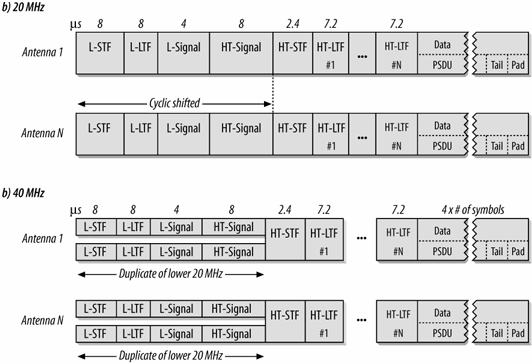
Legacy header
The first three fields in the TGnSync PLCP frame are identical to the 802.11a/g PLCP header.
L-STF (Legacy Short Training Field)
The legacy short training field is identical to its definition in 802.11a. It lasts eight microseconds.
L-LTF (Legacy Long Training Field)
The legacy long training field is identical to its definition in 802.11a. It also lasts eight microseconds.
L-SIG (Legacy Signal)
These three fields are identical to the corresponding fields used by 802.11a and adopted by 802.11g. For details, see Figure 13-16. The L-SIG field is transmitted using BPSK, R=1/2 modulation and coding.
The contents of the L-SIG field is ignored by TGnSync stations. When spoofing protection is employed, the contents of the legacy signal field are not descriptive. TGnSync stations will look in the high-throughput headers following the legacy headers for the actual length and coding rate of the enclosed MAC frame.
To take advantage of the spatial diversity that is the result of having multiple antennas transmitting the same legacy header, TGnSync offers an optional cyclic delay. Each antenna transmits its legacy frame with a slight alteration in its cyclic prefix length, such that the total delay shift is 50 ns.
When 40 MHz channels are used, as in Figure 15-17 (b), the legacy header is transmitted on each 20 MHz subchannel. That is, subcarriers -58 to -6 in the lower 20 MHz subchannel and subcarriers +6 to +58 in the upper 20 MHz subchannel both transmit the older 802.11a-style header.
High Throughput header
Immediately following the legacy preamble is a "high throughput" header specific to the TGnSync proposal. The main component of the high throughput header is the high throughput signal (HT-SIG) field, which is shown in Figure 15-18. The HT-SIG field is used to detect whether a frame carries TGnSync-encoded data at high data rates, or if it is merely a legacy data frame. The HT-SIG field is modulated conservatively, using Q-BPSK, R=1/2 modulation and coding. Q-BPSK uses two data points in its constellation, but they are present on the in the quadrature component. The Q-BPSK constellation is compared to the BPSK constellation in Figure 15-18 (b).
The three-byte high-throughput header is composed of several fields, and is transmitted in the order shown. Least significant bits in each field are transmitted first.
Figure 15-18. TGnSync HT-SIG field
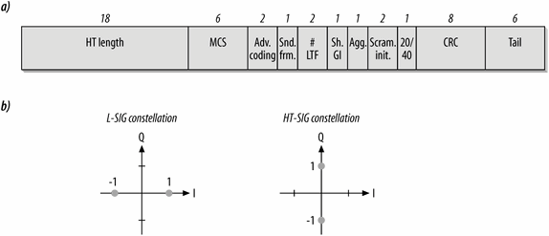
HT-Length (18 bits)
This field is the number of bytes in the payload of the PLCP frame. When aggregation is used, it may be quite large if several full-size MAC frames are included in the payload.
Modulation and Coding Set (MCS) (6 bits)
One of the disadvantages to using MIMO is that there are myriad options when you account for different modulation schemes, differing numbers of spatial streams, and different code rates. The MCS field selects the modulation and coding scheme, along with the number of spatial streams. Values of 0-31 are used for basic MIMO modes, and values of 33-63 are used for advanced MIMO modes.
Advanced Coding (2 bits)
This two-bit field is used to indicate whether the optional advanced coding is used. No advanced coding is indicated by zero. LDPC is indicated by 1. Reed-Solomon coding is indicated by 2. The value 3 is not used.
Sounding packet (1 bit)
Requests and responses used to measure channel performance set this bit. When set, it indicates that every antenna is transmitting its own spatial stream. If it is not set, then the frame should not be used to measure channel information.
Number of HT-LTFs (2 bits)
Following the HT-Signal field are high-throughput training fields. Each spatial stream requires a training field.
Short Guard Interval (1 bit)
When set to one, this bit flag indicates that the short 400 ns guard interval is used on MIMO symbols in the Data field of the frame.
Aggregation (1 bit)
If this bit is set to one, it indicates that the PLCP frame carries several MAC frames in an aggregate burst.
Scrambler initialization (2 bits)
These two bits are used to seed the scrambler.
20/40 BW (1 bit)
If set to one, this bit indicates that a 40 MHz channel is used. When set to zero, it indicates a 20 MHz channel.
CRC (8 bits)
The CRC is used to protect the legacy signal field, and all the fields in the HT-SIG field before the CRC.
Tail (6 bits)
The HT-SIG field is protected by a convolutional code, and as always, six bits are needed to ramp down the convolutional coder.
High-Throughput training fields
Following the high-throughput headers are high-throughput short and long training fields. A single short training field spans the entire operating channel. In 20 MHz channels, the bandwidth of the high-throughput short training field (HT-STF) is 20 MHz. When the wider 40 MHz channels are used, the HT-STF has a bandwidth of 40 MHz. The short training field fine-tunes the receivers in MIMO operation.
When several spatial streams are transmitted over several chains, finer control of the amplification applied to the incoming signal is important. Long training fields (HT-LTFs) are used to further tune each receiver chains. One HT-LTF is used for each spatial stream. In basic MIMO mode, there is one receiver chain for each spatial stream; in the advanced mode, there may be more receiver chains than spatial streams.
Data, tail, and padding
Data bits are encoded according to modulation and coding methods that are defined by the high-throughput header. Like other OFDM physical layers, data is scrambled before transmission, using the scrambler initialization bits in the high-throughput header. Following the data, there is a six-bit tail that ramps down the convolutional code, and enough padding bits to make the data to be transmitted equal to the symbol block size.
TGnSync PMD
The basic design of a TGnSync transceiver is shown in Figure 15-19, which depicts the design of a beamforming transmitter, rather than a basic MIMO transmitter. An incoming scrambled frame is handed to the forward-error correction coder, which is usually a convolutional coder. Coded bits from the FEC coder are then sent to different spatial streams by the spatial parser, which is responsible for dividing the unified bit stream into subsidiary streams for transmission. Each spatial stream is punctured up to the desired rate. In the beamforming mode, the puncturing occurs for each spatial stream and may occur at different rates. Basic transmitters must puncture every stream to the same rate. (Logically, the puncturing in the basic MIMO transmitter can occur before the spatial parser.) Each spatial stream now consists of a sequence of coded bits, ready for mapping on to OFDM carriers by the interleaver. After the interleaver, each block of bits can be mapped on to a single symbol by the constellation mapper. In the basic MIMO mode, each interleaved spatial stream is processed by a single transmission chain; the advanced mode uses a spatial steering matrix to assign symbols to any transmit chain. The spatial steering matrix shown in the figure could be replaced by a one-to-one interface between the spatial stream processors and the transmit antennas for basic MIMO operation. Each transmit chain takes its symbol sequence and modulates it on to the airwaves. There is no mention in the specification of required channel rejection or sensitivity performance.
Figure 15-19. 2x2 TGnSync MIMO transceiver
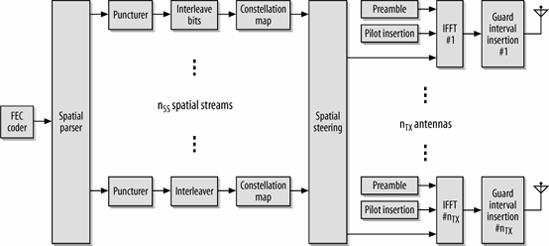
Introduction to Wireless Networking
- Introduction to Wireless Networking
- Why Wireless?
- What Makes Wireless Networks Different
- A Network by Any Other Name...
Overview of 802.11 Networks
- Overview of 802.11 Networks
- IEEE 802 Network Technology Family Tree
- 11 Nomenclature and Design
- 11 Network Operations
- Mobility Support
11 MAC Fundamentals
- 11 MAC Fundamentals
- Challenges for the MAC
- MAC Access Modes and Timing
- Contention-Based Access Using the DCF
- Fragmentation and Reassembly
- Frame Format
- Encapsulation of Higher-Layer Protocols Within 802.11
- Contention-Based Data Service
- Frame Processing and Bridging
11 Framing in Detail
- 11 Framing in Detail
- Data Frames
- Control Frames
- Management Frames
- Frame Transmission and Association and Authentication States
Wired Equivalent Privacy (WEP)
- Wired Equivalent Privacy (WEP)
- Cryptographic Background to WEP
- WEP Cryptographic Operations
- Problems with WEP
- Dynamic WEP
User Authentication with 802.1X
- User Authentication with 802.1X
- The Extensible Authentication Protocol
- EAP Methods
- 1X: Network Port Authentication
- 1X on Wireless LANs
11i: Robust Security Networks, TKIP, and CCMP
- 11i: Robust Security Networks, TKIP, and CCMP
- The Temporal Key Integrity Protocol (TKIP)
- Counter Mode with CBC-MAC (CCMP)
- Robust Security Network (RSN) Operations
Management Operations
- Management Operations
- Management Architecture
- Scanning
- Authentication
- Preauthentication
- Association
- Power Conservation
- Timer Synchronization
- Spectrum Management
Contention-Free Service with the PCF
- Contention-Free Service with the PCF
- Contention-Free Access Using the PCF
- Detailed PCF Framing
- Power Management and the PCF
Physical Layer Overview
- Physical Layer Overview
- Physical-Layer Architecture
- The Radio Link
- RF Propagation with 802.11
- RF Engineering for 802.11
The Frequency-Hopping (FH) PHY
- The Frequency-Hopping (FH) PHY
- Frequency-Hopping Transmission
- Gaussian Frequency Shift Keying (GFSK)
- FH PHY Convergence Procedure (PLCP)
- Frequency-Hopping PMD Sublayer
- Characteristics of the FH PHY
The Direct Sequence PHYs: DSSS and HR/DSSS (802.11b)
- The Direct Sequence PHYs: DSSS and HR/DSSS (802.11b)
- Direct Sequence Transmission
- Differential Phase Shift Keying (DPSK)
- The Original Direct Sequence PHY
- Complementary Code Keying
- High Rate Direct Sequence PHY
11a and 802.11j: 5-GHz OFDM PHY
- 11a and 802.11j: 5-GHz OFDM PHY
- Orthogonal Frequency Division Multiplexing (OFDM)
- OFDM as Applied by 802.11a
- OFDM PLCP
- OFDM PMD
- Characteristics of the OFDM PHY
11g: The Extended-Rate PHY (ERP)
- 11g: The Extended-Rate PHY (ERP)
- 11g Components
- ERP Physical Layer Convergence (PLCP)
- ERP Physical Medium Dependent (PMD) Layer
A Peek Ahead at 802.11n: MIMO-OFDM
11 Hardware
- 11 Hardware
- General Structure of an 802.11 Interface
- Implementation-Specific Behavior
- Reading the Specification Sheet
Using 802.11 on Windows
11 on the Macintosh
Using 802.11 on Linux
- Using 802.11 on Linux
- PCMCIA Support on Linux
- Linux Wireless Extensions and Tools
- Agere (Lucent) Orinoco
- Atheros-Based cards and MADwifi
- 1X on Linux with xsupplicant
Using 802.11 Access Points
- Using 802.11 Access Points
- General Functions of an Access Point
- Power over Ethernet (PoE)
- Selecting Access Points
- Cisco 1200 Access Point
- Apple AirPort
Logical Wireless Network Architecture
- Logical Wireless Network Architecture
- Evaluating a Logical Architecture
- Topology Examples
- Choosing Your Logical Architecture
Security Architecture
- Security Architecture
- Security Definition and Analysis
- Authentication and Access Control
- Ensuring Secrecy Through Encryption
- Selecting Security Protocols
- Rogue Access Points
Site Planning and Project Management
- Site Planning and Project Management
- Project Planning and Requirements
- Network Requirements
- Physical Layer Selection and Design
- Planning Access-Point Placement
- Using Antennas to Tailor Coverage
11 Network Analysis
11 Performance Tuning
Conclusions and Predictions
EAN: 2147483647
Pages: 179
- Challenging the Unpredictable: Changeable Order Management Systems
- The Second Wave ERP Market: An Australian Viewpoint
- Enterprise Application Integration: New Solutions for a Solved Problem or a Challenging Research Field?
- Distributed Data Warehouse for Geo-spatial Services
- Relevance and Micro-Relevance for the Professional as Determinants of IT-Diffusion and IT-Use in Healthcare
